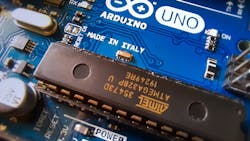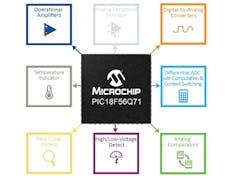The 8-Bit MCU’s Analog Evolution and New Role in Electronics
What you’ll learn:
- Three common applications where a new class of 8-bit MCUs with advanced analog filtering capabilities support modern systems.
- As embedded designs have evolved, the 8-bit MCU has evolved from simple compute devices to full-fledged system-on-chip devices built to handle most today’s embedded tasks.
- The intelligent analog peripherals available on 8-bit PIC and AVR MCUs integrate seamlessly with digital peripherals to deliver even greater functionality and flexibility for tomorrow’s sophisticated embedded systems.
Microcontrollers (MCUs) play a significant role in transforming our lives, with almost all products having some semiconductor componentry. Modern electronics need MCUs for increased functionality in every application and market segment, from automotive, aerospace, and consumer electronics to industrial and healthcare.
Though 8-bit microcontrollers have been around for nearly five decades, new product innovations and applications such as electric vehicles, e-bikes, home and industrial automation, and Internet of Things (IoT) devices have grown exponentially. Thus, demand for these small, inexpensive MCUs has never been higher.
In turn, 8-bit MCUs have evolved to keep pace with the functionality required of modern applications. We’ll examine three common applications where a new class of 8-bit MCUs with advanced analog filtering capabilities support these modern systems by increasing system performance and accelerating response to system events.
Battery Management, Monitoring, and Optimization
Many embedded systems, including IoT systems, are used in remote locations with a battery as a main power source. Monitoring battery life and health is an important function for safe and reliable operation in these applications.
In a typical battery-monitoring system, an MCU is used to automate the measurement of remaining battery life and manage battery health for optimal battery performance. An MCU with an integrated analog-to-digital converter (ADC) reads and converts the measured current and voltage values of the battery to digital data that the MCU can use to estimate that battery’s health. The battery’s performance may be reported to external devices through built-in communication interfaces such as UART, SPI, and I2C for connectivity for IoT designs.
If battery temperature monitoring is also needed, the controller’s integrated op amp may be used as bias for a temperature sensor. On-chip op amps are available on a wide range of modern 8-bit MCUs. They can reduce system cost and space required by external components in any application requiring a gain stage before analog-to-digital conversions, such as weak analog signals.
To optimize battery performance and extend system runtimes, the ideal MCU will offer different power-management modes to balance the need for performance while optimizing power consumption. The key to long battery life in an embedded system is the ability to reduce system activity when it’s not needed.
Flexible levels of configuration enable the system to consume minimal power for the tasks at hand, often without supervision from the central processing unit (CPU). Features like IDLE, DOZE, or SLEEP modes help save power to reduce active power consumption.
In addition, on the latest Microchip PIC and AVR MCUs, ADCs, op amps, and digital-to-analog converters (DACs) can also be toggled on or off in software or set to trigger the MCU’s core and digital peripherals upon reaching certain thresholds. This provides added flexibility and power savings in battery-powered applications. With such low-power features available on modern MCUs, battery life is maximized while reducing current consumption, power dissipation, and costs.
Embedded-System Management
As embedded applications gain complexity over time, it becomes necessary to distribute processing tasks in a manner that ensures lightning-fast system response to maximize user experience or to adhere to strict safety standards.
To achieve that goal, complex systems often take advantage of modern 8-bit MCUs because of the integrated analog peripherals that perform “housekeeping” tasks. These tasks include controlling power rails, monitoring environmental quality and hazard conditions, or arbitrating communications between several chips on a board. Such functions are key for many applications, including data-center infrastructure, building management systems, smart-grid endpoints, and safety-critical applications like household washers and dryers.
One example is a typical server found in a data center. While each server mainboard hosts a main server CPU and a wide variety of application processors to handle various tasks, many of these servers use modern 8-bit MCUs as “system management” devices. The MCUs typically provide a nexus for various environmental sensors (temperature, humidity, voltage rail health) and are programmed to report status on a system management bus while power-sequencing other devices on the mainboard as conditions dictate.
In these cases, 8-bit MCUs are perfect for such tasks because of their on-chip analog peripherals, as well as their simplicity of operation, flexibility, and robustness. Certain microcontrollers, e.g., Microchip's PIC and AVR MCUs, offer core independent peripherals (CIPs) that work in tandem with on-chip analog peripherals to provide system monitoring for critical events and ensure proper operation. Integrated analog peripherals—e.g., an op amp or ADC—supply the signal amplification, filtering, and conditioning needed when acquiring the analog signal.
On the other hand, CIPs are designed to automate system tasks with no code or supervision from the CPU core, reducing the amount of code to write, debug, and validate, making applications more responsive to system changes. CIPs communicate with each other, which further helps increase system performance and responsiveness, while multiple tasks can be handled simultaneously.
PIC and AVR MCUs take the concept one step further and employ sophisticated analog peripherals with dedicated hardware to allow for advanced core independent computation such as averaging, oversampling, and low-pass filtering. These features help quicken system response and offer strong noise rejection for demanding environments.
Those special analog peripherals can be interconnected with many other on-chip signals, including timers or other clock sources, digital peripheral signals, and others, to automatically trigger processes or generate interrupt conditions to notify the CPU.
User Interface
Touch-sensing technology is used in a broad range of electronic products from smartphones to consumer appliances and automobiles. In the automotive space, steering wheels and dashboards are moving away from buttons and toward sleek, flexible user interfaces. These touch buttons must be immediately responsive to user interaction, impervious to false triggers, and adapt to many different environmental conditions, including rapid cold-to-hot temperature swings, wet surfaces, and gloved hands.
In today’s capacitive-touch systems, the raw processing power of 32-bit MCUs can’t replace the purpose-built analog interconnectivity found on modern 8-bit devices. For example, Microchip’s latest 8-bit MCUs, including the PIC18-Q71 and AVR EA product families, have differential ADCs with advanced filtering capabilities that act as “analog processing modules” to significantly reduce the amount of CPU intervention (and therefore, code) needed to implement touch sensing applications.
Specialized on-chip ADCs have strong noise-rejection characteristics and offer built-in automatic tuning and calibration for enhanced noise immunity and water tolerance. Combined with Microchip’s touch-focused development tools, these MCUs can provide a complete solution to build touch interfaces that are exposed to harsh environments.
Conclusion
With the increase in microcontroller requirements over the past 50 years, the lines between what needs to be analog and what needs to be digital are blurred in an embedded system. As embedded designs have evolved, 8-bit MCUs have morphed from simple compute devices to full-fledged system-on-chip (SoC) devices built to handle most of today’s embedded tasks.
From housekeeping, system management, and monitoring to “main controller” duties in complex designs, MCUs with integrated analog peripherals enable designers to bring functions typically performed off-chip onto the main MCU, improving system response and reducing bill-of-materials (BOM) costs.
The intelligent analog peripherals available on 8-bit PIC and AVR MCUs integrate seamlessly with digital peripherals to deliver even greater functionality and flexibility for tomorrow’s sophisticated embedded systems. To learn more about how advanced analog peripherals can be used to solve design problems, click here.
About the Author
Stephanie Pinteric
Product Marketing Manager, MCU8 Business Unit, Microchip Technology
Stephanie Pinteric is senior product marketing engineer in Microchip's MCU8 business unit. In this role, she is responsible for product definition and promotion of 8-bit PIC and AVR microcontrollers. Prior to joining Microchip Technology, she worked in various roles at Motorola/Freescale Semiconductor. She holds a Bachelor of Science in electrical engineering from University of Hawaii and an MBA from St. Edward's University.



